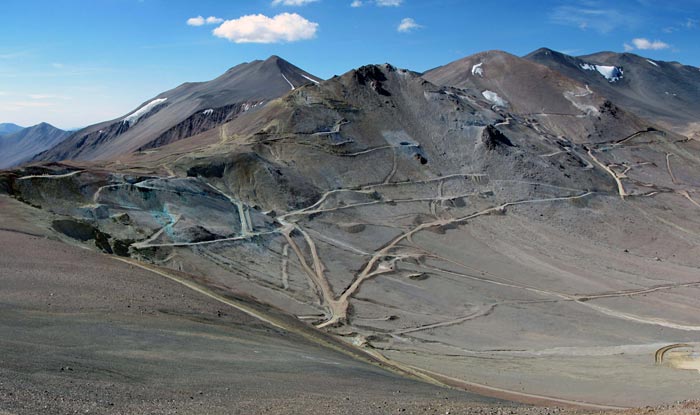NGEx Resources (TSX: NGQ; US-OTC: NGQRF) has bulked up the resource at its Filo del Sol silver-copper-gold deposit, located in Argentina’s San Juan province, and is taking a step back to evaluate how to expand the epithermal system’s footprint.
“A lot of people look at these resources as an end point to an exploration program, but in this case, it really isn’t,” president and CEO Wojtek Wodzicki tells The Northern Miner during a phone interview.
“It’s a midstream report, and we see a lot more potential here to find things that we weren’t expecting,” he adds.
The resource estimate saw a 42% and 39% increase in contained copper and gold, which rose to 3.3 billion lb. copper and 4 million oz. gold.
The inferred resource is 381 million tonnes at 0.4% copper, 0.33 gram gold per tonne and 12 grams silver per tonne. Contained silver grew 71% to 149.8 million oz. silver since the last estimate last December year.
The deposit includes oxide and sulphide portions and occurs within a shallow-dipping, permeable volcanic layer that extends 2.8 km north–south, 1 km east–west and open in all directions.
Wodzicki says the resource drilling improved the company’s geological model and understanding that Filo del Sol could be part of a large, mineralizing system.
“We’re seeing higher-temperature minerals to the north and an increase in the number of higher-grade gold hits, and those are all things you’d expected to see, as you go to the higher temperature part of the system,” he says. “All those vectors point us towards an area where we haven’t done a lot of work yet, and that’s one of the things we’ll look at during the Southern Hemisphere summer.”
Wodzicki has his eye on one step-out hole drilled 1.5 km to the north of the resource that returned 23 metres of 39.5 grams silver per tonne.
“It looks like the same stratabound zone as the resource — it’s right along trend and a prominent geophysical anomaly heads off in that direction, so there’s arm-waving potential to extend the resource out that far,” he says.
Step outs drilled 1 km and 480 metres south of the resource returned 40 metres at 1.2% copper and 62 metres at 0.6% copper and 0.43 gram gold, but the company has yet to define whether the mineralization correlates with the resource.
Filo del Sol is located 17 km south of two more porphyry projects — Los Helados and Josemaria — which are funded by Pan Pacific Copper and Japan Oil, Gas & Metals National Corp.
The deposits carry a combined indicated resource of 2.9 billion tonnes of 0.4% copper, and 0.17 gram gold. Inferred tonnes add 1.1 billion tonnes of 0.3% copper and 0.12 gram gold.
But NGEx would need a total of US$4.3 billion in capital if it wants to fully unlock the value buried in the ground, according to a preliminary economic assessment (PEA) last year that contemplated Los Helados as a stand-alone mining operation.
“We’re just finishing up an integration study that will evaluate the economics of combining both of the porphyry deposits,” he says, adding that the updated PEA will be ready in the new year. “We always talked about this whole land package as a district that could have multiple deposits feeding a centralized processing plant, and this PEA will be the first time we put some hard numbers around that and really show people what the potential can be.”
Wodzicki hopes to add Filo del Sol into the equation, and although the epithermal system is metallurgically different than Los Helados and Josemaria, he says there are more porphyry systems on the property.
“We may be looking at one large porphyry system with the epithermal zone over part of it, or we may be looking at two porphyry systems — one to the south exposed at surface, and another one that’s deeper beneath the epithermal resource,” he says, mentioning that the outcropping porphyry target to the south has yet to be drill-tested.
“[Next year] is going to be a think-tank session for us. We’re preparing to go into areas where we have a lot less knowledge, so we want to make sure we’ve done all the cheap surface work, before we do the next round of drilling,” he continues. “The footprint of the system spans over 6 km, and you can’t just grid-drill the alteration zone, you need to be smart — especially in this market, when raising money is difficult. We have gaps in the induced-polarization coverage and a limit to the magnetics. We plan to fill these in and extend out to the edges of the system, then design a drill program from there.”
News of the resource update drove NGEx shares up 98% to 95¢ per share, and they have since slipped to 68¢ at press time. The company’s shares have traded in a 52-week range of 44¢ to $1.25.
There are 187.7 million shares outstanding for a $128-million market capitalization.
Scotiabank analysts have an “outperform” rating on the company, and have a $1.70 target price on the stock.


Be the first to comment on "Blue sky for NGEx at Filo del Sol"